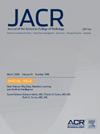取消费用对数字乳房断层合成使用的影响,以减少医疗保健差距。
IF 5.1
3区 医学
Q1 RADIOLOGY, NUCLEAR MEDICINE & MEDICAL IMAGING
引用次数: 0
摘要
背景:继2011年FDA批准数字乳腺断层合成(DBT)之后,许多保险公司在没有成本分担的情况下采用全覆盖的做法进展缓慢。我们的机构对DBT实施了45美元的自付费用,在保险支付时退还。在大多数保险公司开始承保DBT后,这项费用于2021年1月取消。我们在不同的患者群体中评估了自费取消对DBT和数字乳房x光检查(DM)使用的影响。方法:回顾性分析2018年3月至2022年8月在某多地点学术机构进行的乳房x线筛查。我们对切除乳房费用前后接受乳房x光筛查的女性进行了差异中差异分析,以评估切除乳房费用对不同患者组的影响。结果:13284名女性(平均年龄61.5±11.2岁)中,DBT使用率从干预前的83.7%(11,123/13,284)上升至干预后的91.5%(12,256/13,284)。相对于白人患者,亚洲患者DBT使用率的上升幅度为5.0个百分点(pp) (95%CI=3.7-6.2),黑人患者为6.2个百分点(95%CI=5.0-7.3),西班牙裔患者为6.2个百分点(95%CI=4.9-7.5)。非英语患者比英语患者DBT使用增加更大(7.1 pp;95% ci = 6.1 - -8.1)。医疗补助(6.7);95%CI=4.8-8.5)和商业保险(5.1 pp;95%CI=3.8-6.4)患者DBT使用率高于医保患者。来自社会经济条件较差地区的患者与来自社会经济条件较差地区的患者相比,DBT使用率有更大的增加(5.2 pp;95% ci = 4.1 - -6.8)。结论:消除自付费用可提高DBT的整体利用率,缩小差异。然而,持续存在的不平等表明,需要采取额外的战略,确保所有接受乳房x光筛查的妇女公平获得DBT。本文章由计算机程序翻译,如有差异,请以英文原文为准。
Effect of Fee Removal on the Use of Digital Breast Tomosynthesis to Minimize Health Care Disparities
Background
After FDA clearance of digital breast tomosynthesis (DBT) in 2011, many insurers were slow to adopt full coverage without cost sharing. Our institution implemented a $45 out-of-pocket fee for DBT, refunded upon insurance payment. This fee was eliminated in January 2021 after most insurers began covering DBT. We evaluated the effect of out-of-pocket fee removal on DBT versus digital mammography use across patient groups.
Methods
We conducted a retrospective analysis of screening mammograms scheduled at a multisite academic institution between March 2018 and August 2022. A difference-in-difference analysis was performed for women with screening mammography both before and after fee removal to assess the effect of fee removal across patient groups.
Results
Among 13,284 women (mean age, 61.5 ± 11.2 years), DBT utilization increased from 83.7% (11,123 of 13,284) pre-intervention to 91.5% (12,256 of 13,284) postintervention. Relative to White patients, the rise in DBT utilization was greater by 5.0 percentage points (pp) for Asian patients (95% confidence interval [CI] = 3.7-6.2), 6.2 pp for Black patients (95% CI = 5.0-7.3), and 6.2 pp for Hispanic patients (95% CI = 4.9-7.5). Non-English-speaking patients had a larger increase in DBT usage than English-speaking patients (7.1 pp; 95% CI = 6.1-8.1). Medicaid (6.7 pp; 95% CI = 4.8-8.5) and commercially insured (5.1 pp; 95% CI = 3.8-6.4) patients showed a greater rise in DBT usage than patients with Medicare. Patients from more socio-economically disadvantaged areas had a greater increase in DBT utilization compared with those from less disadvantaged areas (5.2 pp; 95% CI = 4.1-6.8).
Conclusion
Eliminating out-of-pocket cost for DBT improved overall utilization and narrowed disparities. However, persistent inequities suggest additional strategies are needed to ensure equitable access to DBT for all women undergoing screening mammography.
求助全文
通过发布文献求助,成功后即可免费获取论文全文。
去求助
来源期刊

Journal of the American College of Radiology
RADIOLOGY, NUCLEAR MEDICINE & MEDICAL IMAGING-
CiteScore
6.30
自引率
8.90%
发文量
312
审稿时长
34 days
期刊介绍:
The official journal of the American College of Radiology, JACR informs its readers of timely, pertinent, and important topics affecting the practice of diagnostic radiologists, interventional radiologists, medical physicists, and radiation oncologists. In so doing, JACR improves their practices and helps optimize their role in the health care system. By providing a forum for informative, well-written articles on health policy, clinical practice, practice management, data science, and education, JACR engages readers in a dialogue that ultimately benefits patient care.
 求助内容:
求助内容: 应助结果提醒方式:
应助结果提醒方式:


